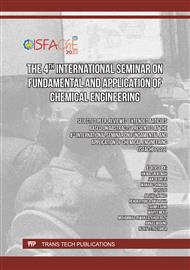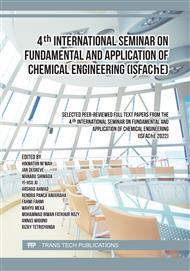p.27
p.33
p.51
p.71
p.79
p.89
p.97
p.105
p.115
Treatment of Laboratory Wastewater with High Sulfate Concentrations Using Eco-Enzyme as an Environment-Friendly Coagulant
Abstract:
Laboratory activities for testing nitrogen levels of natural rubber production are carried out to determine the nitrogen content to meet the Standard Indonesian Rubber (SIR). The test parameters use hazardous chemicals such as strong acids, i.e. sulfuric acid, which have corrosive properties. Testing activities in the laboratory will produce by-products in the form of liquid wastewater containing high sulfate concentrations. A cheap and environmentally friendly wastewater treatment system is required in this research, namely a coagulation-flocculation system using eco-enzyme as a liquid coagulant. Eco-enzyme is a fermented product of household organic waste from the remaining vegetables and fruit peels that are still fresh with a 1:3:10 formula after around 3 months. The purpose of this research was to determine the levels of COD, TDS, and sulfate concentrations as an indicator of wastewater quality standards that are safe for the environment. It is necessary to know the effectiveness of the eco-enzyme as a coagulant in treating laboratory wastewater with various concentrations of 1, 5, 10, 20, and 40% v/v. As well as variations in monitoring time of 5, 10, 15, 20, and 30 days. In this study, laboratory waste treatment with Eco-Enzyme as a coagulant resulted in a decrease in sulfate levels at 29.8 mg/L found at 1% v/v Eco-Enzyme concentration with monitoring for 30 days. With levels of COD 263 mg/L, TDS 39.7 mg/L, and pH 7.01 at a concentration of 40% v/v Eco-Enzyme. The results of this study indicate that Eco-Enzyme can act as a natural coagulant that is environmentally friendly and can degrade laboratory liquid waste so that it meets wastewater quality standards that are safe for the environment.
Info:
Periodical:
Pages:
79-87
Citation:
Online since:
January 2024
Keywords:
Price:
Сopyright:
© 2024 Trans Tech Publications Ltd. All Rights Reserved
Share:
Citation:




